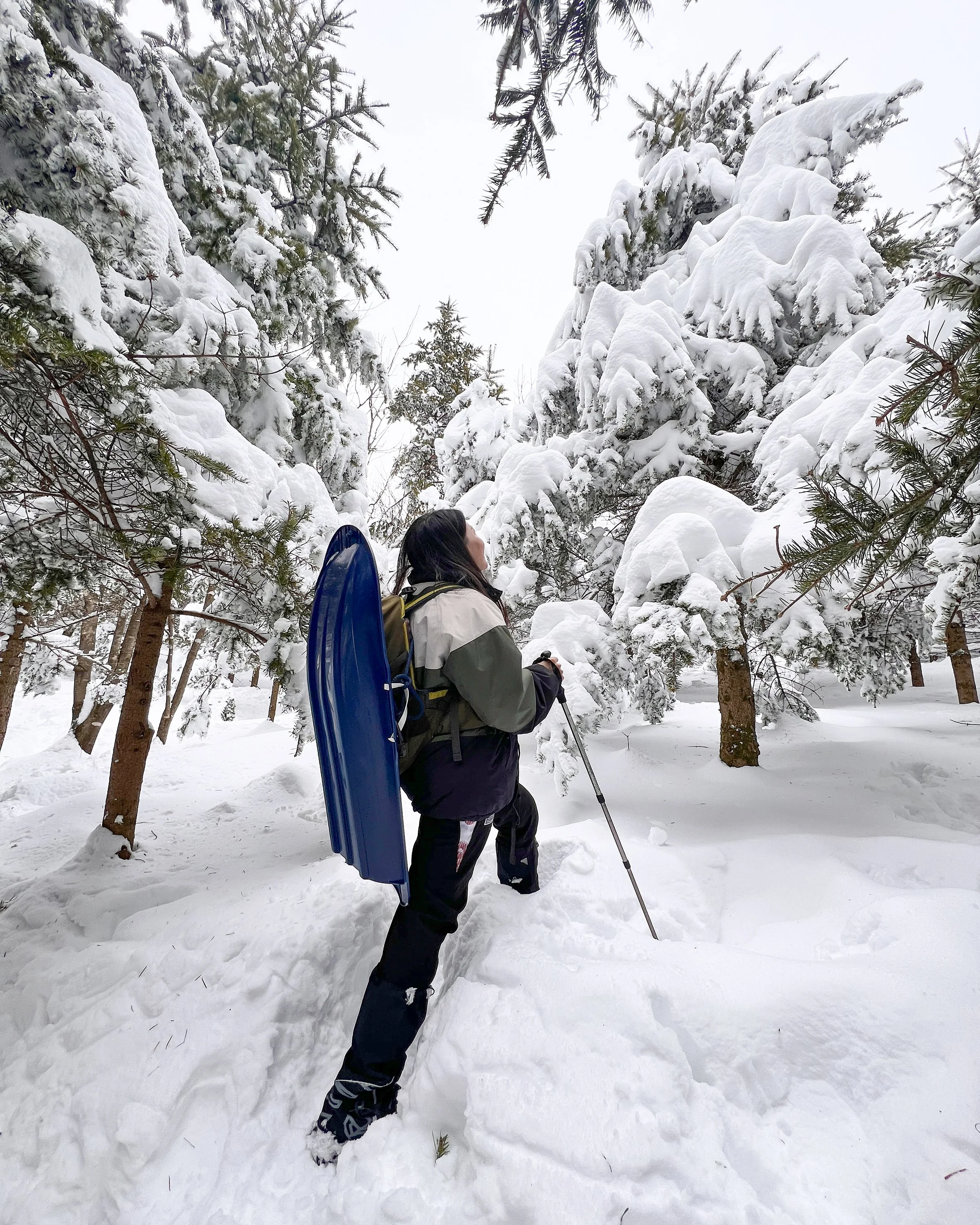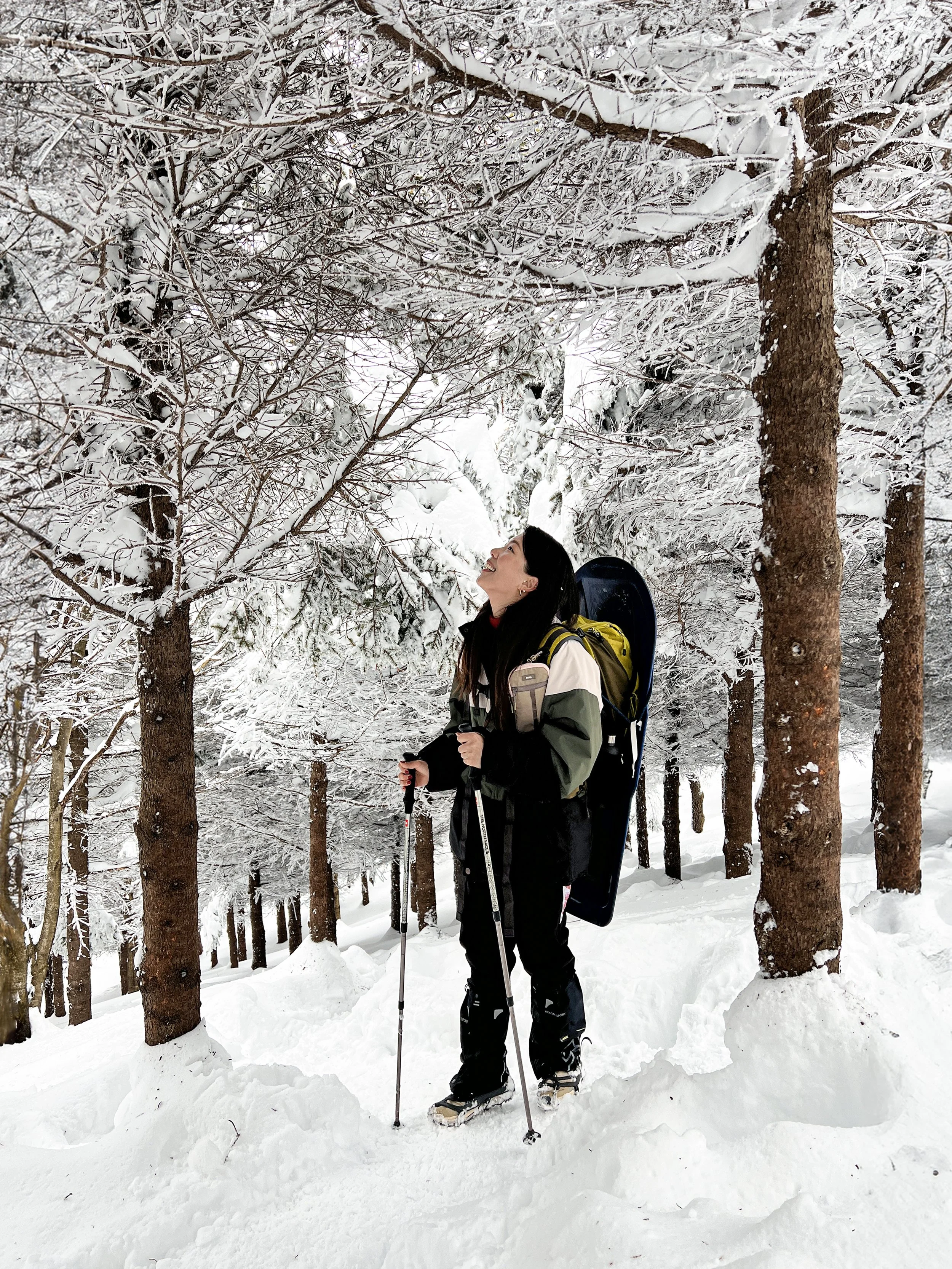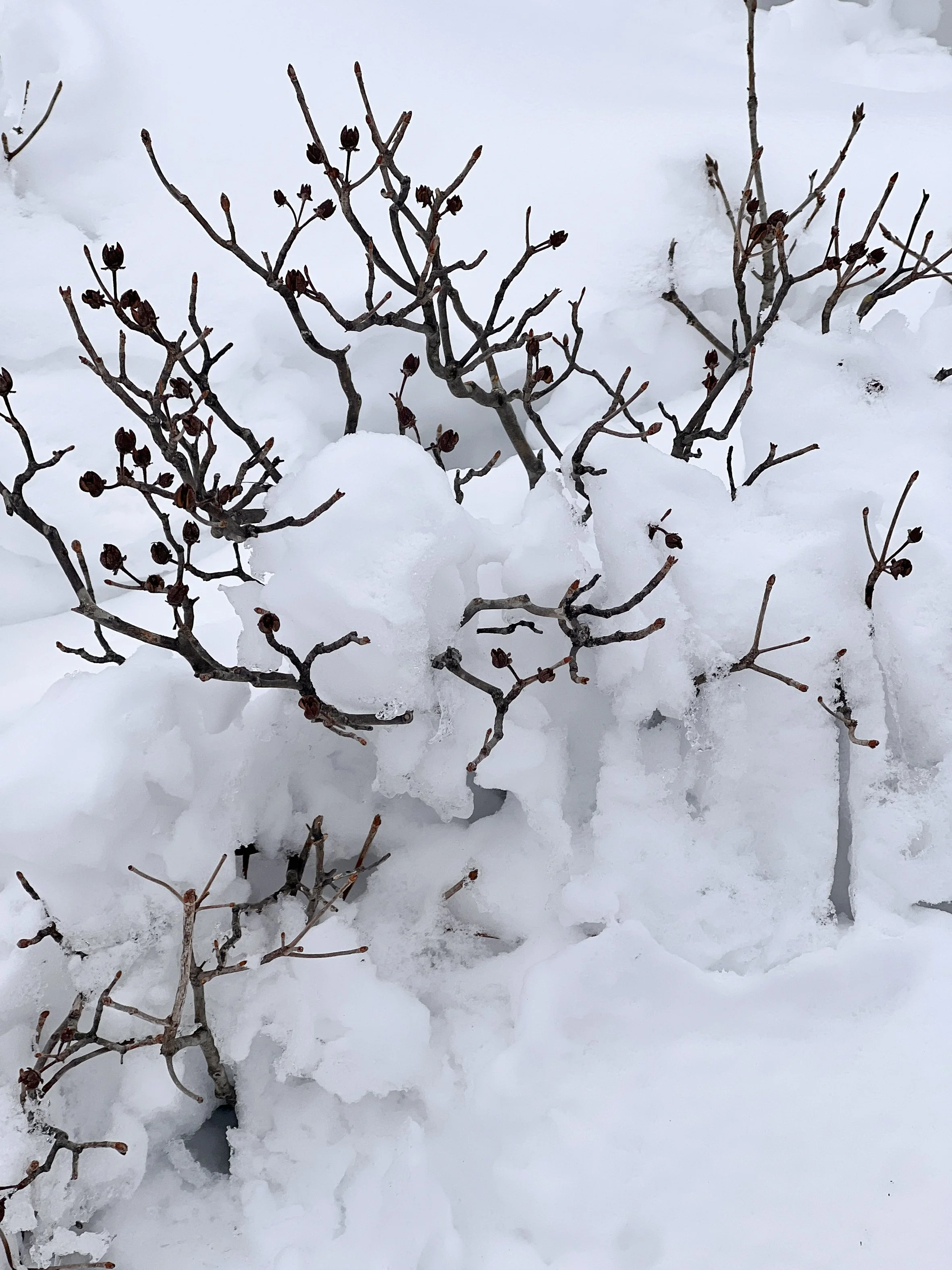Snow Trails to Remember – A Winter Hike with Mom
( Feb.29.2024 )
There’s a saying in Korea about winter: “When heavy snow falls in the Yeongdong region, it means winter is coming to an end.”
Gangwon-do, known for its colder temperatures compared to other parts of the country, is naturally a place where snow is common in winter. But unlike the steady snowfalls of midwinter, what arrives toward the end of the season feels different—unexpected, sometimes intense snowstorms that sweep through from late February into mid-March, and occasionally even into early April.
And this year was no exception. In the third week of February, as we approached the end of the winter, a massive snowstorm hit the Daegwallyeong area, covering it with nearly 70cm of snow over four days.
Today is February 29th—a date that only appears once every four years. (Today would already be March 1st in any other year!) But on this rare leap day, with snow still clinging to the landscape, I headed to Seonja-ryeong with my mom to say goodbye to winter and soak in the magic of the snow-covered mountains one last time.
[ About Yeongdong Area in Korea ]
In Korea, “Yeongdong” refers to the eastern part of Gangwon-do Province, a region east of the Daegwallyeong pass, part of the Taebaek Mountain Range. The name literally means “east of the pass” (Yeong = pass, Dong = east), since it lies beyond the mountainous spine that runs down the Korean peninsula. Cities like Gangneung, Donghae, and Samcheok, along with highland areas like Daegwallyeong, are all part of the Yeongdong region.
Yeongdong has a distinct climate compared to the rest of the country, especially in winter. While the region tends to be colder and snowier than other areas throughout the season, snowfall becomes especially intense toward the end of winter, usually from late February into March. This is largely due to its geographical features. Moist air from the East Sea rises over the Taebaek mountains, cools, and releases heavy snow, a process known as orographic snowfall. As a result, even when much of the country remains dry, Yeongdong can be hit with sudden, intense snowstorms. Because of this geographical weather pattern, record-breaking snowfalls are not unusual in this region, even when spring feels just around the corner elsewhere.
Map of Korea showing regional classifications and topography.
The plum-colored area represents Gangwon Province, which is geographically divided into East and West by the mountainous Daegwallyeong Pass.
Source: National Atlas of Korea, National Geographic Information Institute (http://nationalatlas.ngii.go.kr)
Adventure Begins!
Seonjaryeong is one of Korea’s most beloved winter hiking spots, known for its stunning snow-covered scenery and gentle trails. Since the path is not too steep, it has become a popular destination for hikers and backpackers of all ages. After a heavy snowfall, many people visit to take in the magical white landscape or to enjoy a peaceful backpacking trip through the snow.
After packing gears, some snacks, simple meals, and water into our backpacks, we left home around 8:30 in the morning and drove about two and a half hours toward Seonjaryeong. In Seoul, it already felt like spring was on its way. But as soon as we passed through the Daegwallyeong Tunnel, everything changed. It felt like we had stepped into a winter wonderland. The tunnel felt like a time machine, taking us straight from spring back to winter.
We parked at the Daegwallyeong Village Rest Stop. Luckily, it had been a few days since the snowstorm, and because it was a weekday, it was not crowded at all. I had seen on social media that you could rent sleds at the convenience store, and I thought to myself, "This is it. I have to try this when I go." And sure enough, the sleds were there. After grabbing a quick snack, we rented one for 5,000 KRW for a day. I wondered how we would carry it, but the shop owner strapped it onto my backpack like a pro. With the sled on my back, we headed up the snowy trail. I have to admit, carrying that sled made me feel like a real snow adventurer. It felt kind of epic.
The Seonjaryeong hiking trail is a loop course, starting from the trailhead, leading up to the summit, and eventually bringing you back to where you began. That’s one of the reasons so many people love this trail—you finish right where you parked, without needing to arrange separate transportation.
The full course is about 12 kilometers long, and it usually takes around five hours to complete at a relaxed pace.
Into the Quiet White: Climbing Toward the Peak
With crampons, gaiters, and trekking poles in hand, we stepped onto the snowy mountain trail. The path was already wide and well-packed, showing clear signs that many people had walked through before us. Thanks to that, the climb wasn’t too difficult, and there was no concern about losing our way.
The snow was piled high on either side of the trail, forming soft walls of white that reached up to almost our knees. The leg of convex traffic mirrors stood almost completely buried, with only the mirrors peeking out, like round heads barely surfacing above the snow. It was a quiet, funny sight—and a striking reminder of just how much snow had fallen here.
Seonjaryeong was filled with pine trees, standing tall and still. Since they are evergreens that keep their needles year-round, the snow had settled beautifully on their branches, layering them in soft, white blankets. Some branches drooped low under the weight, as if the trees were bowing or quietly enduring. The trees looked burdened by the weight of the snow, almost as if they were struggling to hold it all – so full of snow that I couldn’t help but wonder if the trees were struggling under all that weight. Yet somehow, their quiet effort made the landscape feel even more deeply winter. The snow-covered pine trees reminded me of Christmas, and filled the air with a calm, peaceful feeling.
Me asking the trees,
“You okay up there?”
My mom’s mountain charm collection.
Not saying I want them… but I want them.
Mini us in the almost-buried corner mirror.
98% snow, 2% hikers.
Just when I thought I had taken in all of the trail’s beauty, the trail would open up to a completely different winter landscape at every stage of the hike.
After passing through a path lined with snow-laden pine trees, we entered a section where the entire forest was coated in hoarfrost. Every branch, every twig, was covered in white flakes, like sour-flavored jellies dusted with sugar, creating a magical, silvery world. I had seen hoarfrost from a distance before, usually while snowboarding, but seeing it up close like this was something else entirely. The delicate textures, tiny frozen crystals, and the way the frost clung to each branch tip were incredible to look at. Hoarfrost had covered everything in a delicate, shimmering layer, turning every tree into frosty sculptures.
The trees in this area stood in evenly spaced rows, which made me think this part of the forest might be man-made.
I started wondering what the story behind this place might be. Was this area restored after a wildfire, with new trees planted to bring life back to the mountain? Had something happened to the forest that once stood here? Or was there another reason behind this quiet, orderly landscape?
Whatever the reason, I felt a quiet sense of respect. Even if it wasn’t nature’s untouched design, someone had cared enough to plant trees here, to try and bring the forest back. And somehow, the trees seemed to acknowledge that effort in their own quiet way. They had taken root, grown together, and endured through the seasons. It wasn’t just beautiful. It felt meaningful. And I was quietly grateful for all of them.
The symmetry made the scene feel even more surreal. It was a kind of winter beauty I had never experienced before, and a kind of gratitude I had not quite felt in that way. It felt unfamiliar, yet comforting. The feeling stayed with me long after we walked on.
Us, wandering through frost-covered trees, taking in the shimmer of winter up close, capturing its quiet magic with our eyes and our camera.
and winter’s lacework, clinging to pine needles and branches, one shimmer at a time.
We kept walking, chatting about this and that as we made our way through the beautiful snow-covered forest. About an hour and a half into the hike, the trail began to level out. We reached a quiet stretch where the incline faded, and the path felt almost flat. It felt like the mountain was offering us a gentle pause.
Just off the trail, between a dense cluster of trees, we spotted a small clearing, just big enough to roll out a sleeping pad. It looked like someone had spent the night there. There were signs of a cozy setup, including a neatly built wall of snow that must have helped block the wind, and even a professional-grade, carefully carved snow fridge. We were grateful to the stranger who had created such a thoughtful resting spot. It felt like a little secret spot shared among hikers. So we borrowed the space for a while and settled in for a short break. Sitting side by side on our compact chairs, we sipped warm tea and let the stillness of the forest wrap around us.
Before the warmth from our shared tea could fade, we packed up quietly and stepped back onto the trail.
Through the Mountain’s Breath, Toward the Summit
We walked through a forest full of bare trees whose leaves are long gone with winter. Without any foliage, I found myself wondering what kinds of trees they were. When spring comes, what colors will they wear? In summer, what shapes will their leaves take? The forest stirred a quiet curiosity, inviting us to imagine the seasons still ahead.
Here and there, before the snow could melt away, little clumps of snow rested gently in the branches. It looked as if they had paused for a moment before returning to water. Between the bare twigs, they created their own quiet display. It was a simple sight, but beautiful in its own quiet way.
After walking for another thirty minutes or so, the trail began to change. It filled with low, waist-high trees and gradually opened into a flat, wide space where the forest seemed to pause. Across the valley, on the other side of the mountain, wind turbines stood still under the pale sky, as if they too were taking a moment to rest.
Before coming here, I had read on blogs and seen on YouTube that this section was known as “the hill of wind.” They said the valley wind climbs up fiercely through this stretch, strong enough to stop you in your tracks. And it made sense. The trees here were small, probably never able to grow tall against the constant push of the wind. Most of them leaned in the same direction, as if bowing together under something invisible but powerful.
But today was different. The air was still. Even the wind turbines across the valley had come to a quiet pause. Only the softest winter breeze brushed past us, just enough to cool us down.
We stood there for a moment, looking around and soaking it in. And I thought to myself, today is our lucky day.
Ridge after ridge, layers of hills stacked quietly behind one another.
A forest of bare trees stretched below, their thin branches tangled like delicate brushstrokes on snow. Between them, the ground was covered in cozy white, offering a soft backdrop that made the brushstrokes stand out. Further along, a grove of pine trees appeared, snow piled gently on their needles, forming thick, cloud-like tufts. Some spaces were left empty, filled only with white, as if left that way on purpose like quiet margins between strokes.
Each layer of the landscape felt distinct, yet they all belonged together. There were slopes filled only with branches, patches of untouched snow resting between trunks, and dark green pine clusters dusted with frost. And then there were the essential margins too, the open spaces that made everything else feel even more alive. Every hill carried its own character, and together they unfolded like a living canvas of textures.
Looking out over the valley, we continued along the final stretch, with just 200 meters left to the summit.
Nature’s quiet composition found in this area. Trees kept low, all leaning in one direction under the breath of the wind. Snow fills the background, and bare twigs quietly endure the season. Nature has its own way of composing textures.
Summit Reached! But Not the End, Just a Beautiful Pause
After about two and a half hours of hiking, we finally reached the summit marker of Seonjaryeong, standing at 1,157 meters above sea level.
Even though it’s technically 1,157 meters high, the rest area where we parked and started our hike sits at around 840 meters. So the actual elevation gain is only about 320 meters, which makes this feel less like a mountain climb and more like a gentle walk with a view. It’s the kind of trail where you can truly enjoy the scenery as you go.
Still, I’ve always believed that coming down is the harder part of any hike. Only after a safe descent can you really say it’s done. So when we reached the summit marker, my first thought was “We’re halfway there!”
There wasn’t a big sense of triumph waiting at the top—but not because it wasn’t meaningful. It was just that every scene along the way had already been so beautiful, so full of small joys, that the summit felt more like another gentle page in the story than a grand finale.
We took our photos, of course. It’s the summit, after all.
But more than anything, I felt excited for what was ahead. A mountain meal that always tastes better at altitude, and of course, the long-awaited sledding session that would finally shine on the downhill stretch.
Finally, It’s a Meal Time!
It wasn’t a difficult hike, but after walking for nearly three hours through the winter mountains, our stomachs were ready. After passing the summit and heading down the loop course, we soon came across a wide, flat clearing that almost made us wonder if we were still deep in the mountains.
Under a cluster of snow-covered pine trees, the snow had been pressed into a neat round patch, marked by footsteps. It seemed like many hikers had stopped here for a break or a meal before continuing on. We put down our bags and decided this would be our lunch spot—a late meal, but the perfect kind in the mountains. From our backpacks, we pulled out compact chairs and a table, laid out a tablecloth, and just like that, our mini picnic site was ready. To keep our bags off the snow, we rested them on top of the sled we had been carrying.
Today's menu was instant ramen rice. Unlike regular instant noodles that need boiling water, this version cooks at slightly lower temperatures, almost like a military-style meal. I first tried it on a family trip to Yosemite National Park, where you have to carry in your food since places to buy meals are scarce once you enter. Out of the different emergency meals I brought on that trip, this ramen turned out to be the most enjoyable, so I packed it again for this hike. All we needed was the warm water we had carried in a thermos, and lunch was ready. While it cooked, I threw on an extra lightweight down jacket to stay warm while sitting still in the cold.
As always, food tastes best after a bit of sweat, and even more so when eaten out in nature. The warm broth and rice in the middle of a chilly, snowy mountain afternoon felt like a gift.
And of course, we followed it with coffee. Normally I don’t drink sweet instant coffee, but it becomes something else entirely in the mountains. That gentle sweetness and aroma felt like the most luxurious treat, right there in the snowy woods.
One tip I’ve picked up over time: when eating or drinking in the mountains, prepare only the amount you can finish. If there’s a chance something might be left over, bring an empty bottle or tumbler to carry it out. Even leftover soup or coffee can harm the natural environment, so I try to avoid leaving behind anything, no matter how small.
After finishing our unforgettable meal in the white forest, we cleaned everything up carefully, packed our bags again, and looked around one last time. With lunch packed away and our energy restored, the highlight of the day was finally ahead—sled time!



















